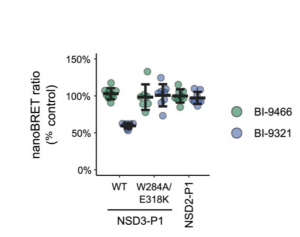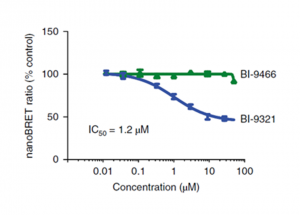Background
NSD3 is a member of the NSD (nuclear receptor SET domain- containing) family of H3K36 methyltransferases. It has two isoforms: long -1437 amino acid and short – 645 amino acids, which are derived from alternative splicing of exon 10. In contrast to long isoform, the short isoform lacks the methyltransferase domain and it contains only one histone methyl-lysine reader domain (PWWP1). The overexpression of both NSD3 isoforms is capable of oncogenic transformation indicating that the oncogenic function is not related to methyltransferase activity. Short NSD3 isoform was shown to sustain AML leukemia by linking BRD4 to the CHD8 chromatin remodeler, through the PWWP chromatin reader domain. (PMID: 20940404, 23269674, 25942451, 26626481)
Assay validation
Assay measuring the interaction of NSD3-PWWP1 to histone H3 was developed using NanoBRET technology – a proximity-based assay that can detect protein interactions by measuring energy transfer from a bioluminescent protein donor to a fluorescent protein acceptor. The assay was optimized and validated using NSD3 and H3 antagonist BI-9466 and W284/E318K binding deficient mutant. The best results were obtained with U2Os cells transfected with C-terminally NanoLuc tagged NSD3-PWWP1 and H3 at 1:10 ratio. As shown in Fig 1. chemical probe antagonist (BI-9466) but not its negative control (BI-9321) selectively decreased the BRET signal only in WT NSD3-PWWP1. No effect was observed on binding deficient W284A/E318K mutant and closely related NSD2-PWWP1 domain. BI-9466 decreased NSD3-PWWP1 and H3 interaction in a dose-dependent manner (Fig2). (PIMID: 31285596)

Fig.1. BI-9466 antagonizes interaction between histone H3 and WT NSD3-PWWP1 but not NSD3-PWWP1(W284A/E318K) mutant or NSD2-PWWP1 in NanoBRET assay. U2Os cells were co-transfected with C-terminally HaloTag Fusion-tagged histone H3 and C-terminally NanoLuc-tagged NSD3-PWWP1, NSD3-PWWP1(W284A/E318K), or NSD2-PWWP1 and treated with 10 µM BI-9321 (antagonist) or BI-9466 (negative control) for 24 h. Shown is the mean ± SD of two biological replicates, run in quadruplicate. (David Dilworth, Magdalena Szewczyk)

Fig.2. BI-9466 but not negative control compound BI-9321 decreases the interaction of NSD3-PWWP1 and histone H3 in a dose-dependent manner. NanoBRET based on the interaction of C-terminally NanoLuc-tagged NSD3-PWWP1 with C-terminally HaloTag Fusion tagged histone H3 with increasing concentrations of either BI-9321 (blue) or control compound BI-9466 (green). Shown is a representative dose-response curve. IC50 was calculated from the mean ± SD of three independent replicates. (David Dilworth, Magdalena Szewczyk)
For experimental details go to Zenodo.
